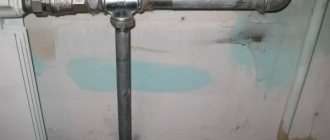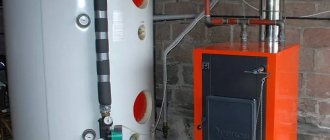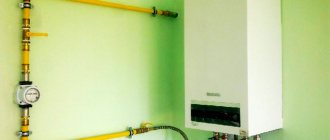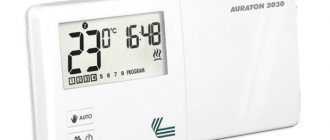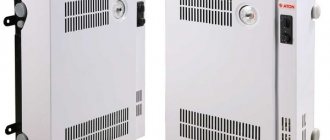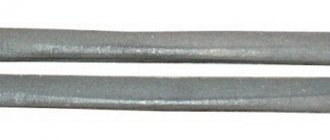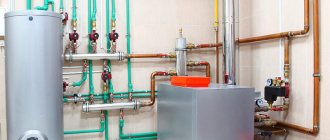Home / Electric boilers
Back
Published: 12/01/2019
Reading time: 4 min
0
3023
Arranging a heating system in a car garage, in situations where centralized heating services are not available, can be a difficult task.
Selecting the optimal electric heating scheme makes it possible to create the required sanitary and hygienic conditions in garage workshops at low outside temperatures, so owners of such premises need to know the basic rules on how to choose an electric boiler for a garage.
Example of EC location in a garage. Photo source: nizhniy-novgorod.dmir.ru
- 1 Types of boilers for garages
- 2 How to calculate boiler power
- 3 Requirements for installing an electric boiler in a garage
- 4 Best brands of garage electric boilers
- 5 How to connect
Two heating systems
There are two fundamentally different heating systems that can be used to heat a garage:
- air;
- water
Air heating is carried out using electric fan heaters, convectors, and oil radiators. This is the simplest heating method. To heat the air in the garage you will need a heating device and an electrical connection. However, after turning off the device, the temperature in the garage drops quickly. This type of heating is suitable if the car owner is in the garage occasionally and spends little time there.
Schematic diagram of water heating
The water system is more reliable. However, when installing it you will have to spend more money and labor. It includes three main parts:
- pipes through which the coolant circulates;
- heat emitter into space (battery);
- coolant heater.
Antifreeze is used as a coolant, since the heating in the garage is turned on periodically, and pipes filled with water can burst when frozen.
Heating boilers are used to heat the coolant. They can be of different types:
- gas;
- electrical;
- solid fuel;
- liquid fuel.
Western European experience
If you type the phrase “garage heating” in the search and look at pictures on English-language sites, you will not find any wood-burning or oil-fired stoves in Western European garages. How do local motorists warm themselves:
- electric portable heaters;
- infrared hanging heaters;
- air heating units (heaters).
The suspended air heating unit does not take up useful space in the garage
We have already discussed the first 2 options above. The third method is also far from new: water heated in the boiler passes through a radiator, blown by a powerful axial fan. Ideally, the unit is suspended from the ceiling and distributes hot air throughout the room.
The advantages of this option are compactness, heating speed and the possibility of air conditioning in the summer (cooled water is sent to the radiator instead of heated water).
Heater made from a car radiator
There is one downside - increased costs for equipment, because the coolant must be heated in the boiler and supplied through pipes to the heater. But if the garage is attached to a private house, then the problem is easily solved by connecting the radiator to the building’s water heating system.
Pros and cons of electric boilers
Each type of boiler has its own disadvantages and advantages. The most optimal heat generator in modern conditions is an electric boiler.
Electricity is available everywhere, in cities and rural areas.
There is no need to install a chimney, buy and store liquid or solid fuel in the garage, or clean the boiler from soot.
Electric boilers are compact and easy to install
Electric boilers are very easy to use. Modern control systems allow them to operate automatically. They make it possible to turn on the heating without entering the garage.
Another advantage is ease of installation. Installing an electric boiler for heating a garage with your own hands is not difficult if you have minimal technical knowledge and work skills.
Electric boilers do not create an open flame to heat water or other coolant. This means they are safer from a fire safety point of view.
The efficiency of new models reaches 99 percent.
They are economical because automation allows you to smoothly regulate their power, thereby reducing energy consumption.
Finally, it should be noted that the industry offers a wide selection of electric boilers of various capacities, designs suitable, as they say, for all occasions.
There are far fewer disadvantages. It may be necessary to install additional wiring when installing a three-phase boiler. The electrical network to which the boiler is connected must have sufficient power for safe operation.
The price of the energy source remains controversial. Some critics point to the high cost of electricity. But prices for gas, electricity and other fuels are constantly changing, so it is difficult to give an unambiguous assessment.
No. 5. Heating with liquid fuel
Fuel can be used oil and diesel. If you need to heat a car repair shop, where used oil is always available, then this is a very good option. You can make a heater for testing yourself. It is based on two chambers: in one the fuel burns, in the other the gas burns out. For manufacturing, you can use gas cylinders, tanks and pipes. As a result, a large amount of energy is generated.
The main advantage of a waste oil furnace is the minimum cost of fuel, and sometimes it is completely free. The downside is the formation of a large amount of soot and soot, so the equipment needs regular cleaning. In addition, lighting such a stove is quite difficult; it doesn’t always work out the first time, and if you come to a cold garage and operate with cold hands, then the task becomes more complicated. There are also requirements for installing a chimney - it must be at least 4 m in length and have a slope.
If your existing skills are not enough to assemble a stove, you will have to buy it; it costs about the same as a gas boiler. Some models are quite sensitive to fuel supply. In addition, to ensure uninterrupted operation of the equipment, it is necessary to have a supply of fuel. The average flow rate is 1 l/hour.
Types of electric boilers
Depending on the heating method, boilers are divided into three types:
- heating elements;
- electrode;
- induction
Boiler on heating elements
Boilers of the first type have been known for a long time and are widespread. The heating element is heating elements (tubular electric heaters), made in the form of a spiral. An electric current flows through the heating elements and they heat up. The heat is transferred to the coolant, which is supplied to the system using a pump and circulates in it.
Disadvantage - heating elements can overheat and burn out if there is a lack of coolant. New heating elements electric boilers are necessarily equipped with protective devices that cut off the power supply if the coolant level in the system is insufficient.
Electrode boiler device
An electrode boiler works on a different principle. Electricity in such a boiler is supplied to electrodes made of special alloys. The coolant acts as an element of the electrical circuit. It has a certain resistance, so the current passing through the coolant heats it.
Such boilers must have good grounding. If it is missing or poorly made, the risk of electric shock increases.
The main elements of an induction boiler are an electromagnetic coil and a heat exchanger. It consists of a metal core inserted inside the coil. When electricity is supplied to the coil, an alternating electromagnetic field appears in it. It creates eddy currents in the core that heat it. Next, the heat is transferred to the coolant.
Induction boiler SAV
Boilers differ according to the design of the body:
- wall;
- floor
Wall-mounted boilers are smaller and more compact. Floor-standing modifications are designed for boilers through which a larger amount of coolant passes.
Based on the electrical voltage, boilers are divided into:
- single-phase;
- three-phase.
In the first case, the operating voltage is 220 volts, in the second case - 380 volts. Boilers with a power of up to eight kilowatts are made single-phase. In the range of 8-12 kW you can find devices of both modifications. If the power is more than 12 kW, the boilers are available in three-phase versions.
Boilers are manufactured with different types of power regulation. Power adjustment allows you to change the heating temperature of the coolant and energy consumption.
Power can be adjusted:
- smoothly;
- by steps.
With stepwise adjustment, heating elements independent of each other are turned on and off.
Smooth regulation is done using a rheostat.
Low-power boilers of simple designs do not provide for adjustment of this operating parameter.
Electric boilers come in different configurations. An electric boiler without additional elements (pump for circulating coolant, safety valve, expansion tank, cleaning filter) is cheaper. But it is better to purchase boilers with a complete set. The listed items will have to be purchased separately, and in the end the cost of money may be large.
Types of electric boilers installed in garages
To choose the right electric boiler for your garage, you need to understand the operating principle used and the associated limitations during operation. There are three types of boilers, differing in their internal structure and principle of heating the coolant:
- Heating element boilers are classified as indirect heating devices. The internal structure of the electric boiler consists of a thermally insulated container, inside of which a heating tubular element is located. The design disadvantage is large heat losses due to indirect heating, as well as the long period of time required for the boiler to reach operating power.
- Electrode boiler – has high energy efficiency. Compared to heating elements, efficiency reaches 40%. The heating principle is based on direct action on the coolant. The device uses two electrodes that create an electromagnetic field and cause the ions to move at a frequency of 50 vibrations per second. The coolant heats up almost instantly. The disadvantage of electrode boilers is the inability to use the unit when connected to low-temperature heating systems. The operation of an electric boiler requires the use of a special coolant with a high salt content.
- Induction boilers - the operating principle is based on the use of an alternating electromagnetic field. A copper core is installed inside the structure. When the electric boiler is turned on, vortex electromagnetic flows or Foucault currents are created. Under the influence of a magnetic field, the metal heats up and transfers heat to the passing coolant. Induction boilers, like heating elements, belong to indirect heating equipment, but are characterized by longer operation. Therefore, electric boilers based on a tubular heater are more economically profitable.
Heating elements, electrode and induction electric boilers for garage heating systems have their advantages and disadvantages. When choosing a suitable model, the characteristics of the heated building are taken into account and the boiler is selected in each specific case.
(no votes yet)
Choosing an electric boiler
The choice begins with determining the required power. This is not difficult to calculate. There is a classic ratio: to heat 10 square meters of an insulated room, the ceiling height of which is not higher than three meters, you need one kilowatt. Thus, you need to calculate the garage floor area. If it is, for example, 30 sq. m., then you need a device with a power of at least 3 kW. Next, you need to make an adjustment of 15-20%, as they say, in reserve. As a result, the optimal power is 4 kW.
Therefore, the boiler will be single-phase. There is no need for additional wiring.
However, the above does not mean that it is impossible to install a boiler of higher power. In this case, heating will occur faster, but the cost of a more powerful device will be higher and electricity consumption will increase.
The next parameter influencing the choice is price. It depends on the degree of advancement of the device. The more electronic filling with increasing functions, the higher the price. Whether extensive functionality is needed is up to the garage owner to decide. It should be noted that the more complex the device, the more likely it is to fail.
The most expensive are induction, followed by heating elements in next place in price. The cheapest are electrode boilers.
The next parameter is the manufacturer. The brand of a well-known manufacturer is a guarantee that the boiler will operate reliably and provide heating in accordance with the characteristics specified in the technical data sheet.
Practical implementation of heating a garage using an electric boiler
At the very beginning, when heating the garage with electricity, you need to choose the installation location for the boiler and radiators. The space should be as open as possible and not interfere with the use of the garage equipment itself, including opening the car doors, or raising its trunk and hood. Next comes the selection of a heating device in the store. Even for a garage of 20 m², a boiler of 1 kW and the cheapest pump will be enough, as long as it can connect and withstand the circulation of hot water through pipes with an internal diameter of 15–20 mm, which will be used to connect the entire system. Plus, you will need an expansion tank and the radiator itself.
Of the specific recommendations, the electric boiler “Economy EVP-3 KW”, costing only 1800 rubles, looks good in this regard. Don't look at large kilowatt/hour values. It doesn't constantly spin electricity. The principle is this: the boiler heats the liquid in the system to the set maximum temperature. Turns off. As long as the heat exchanger is cooled within certain limits, it does not react. As soon as the degrees fall below the bar, it is activated and again raises the temperature of the liquid.
You don’t have to worry about choosing a specific pump either. All circulation options with a consumption of up to or equal to 100 W, located in the price range from 1500 to 2000 rubles, are suitable.
An expansion tank is absolutely necessary so that the system does not fall apart at one nasty moment. You can come up with it yourself - it’s just a container attached to a hot water exchange system. Its main function manifests itself when the liquid expands as a result of heating - the excess goes into this tank. It is better and easier to buy ready-made solutions for such a vessel, equipped with the necessary pipes and adapters. A 2 liter model is quite enough. For example, from the company LadAna, for less than 500 rubles. As for the pipes themselves, it is better to use metal versions or heat-resistant plastic.
If there is no opportunity or desire to buy radiators, then use a homemade bundle of pipes. There is only one principle here - that the maximum amount of hot water be distributed over a larger surface. Although there are neat industrial heat exchangers on sale. They are mainly made of segment modules. A couple of such assemblies, each one meter long, will fully meet the needs of the average garage.
The boiler itself must be connected to the power line through thick copper wires and good circuit breakers at phase and zero, with limits of 25 A. In parallel, a pump is also connected to the power supply. Another nuance related to connecting the latter, but concerning water, they try to put it on the reverse of the system. This is done so that it works at lower fluid temperatures and does not overheat. One more thing. Without a separately removed and mounted “ground” in addition to the “zero”, such powerful equipment simply cannot be used, this applies to both the boiler and the pump.
Insulation of the garage
Before installing heating, it is necessary to properly insulate the garage, since heat leaks through the floor, roof, walls and doors significantly reduce heating efficiency and increase costs. Insulation is carried out using thermal insulation materials (mineral wool, polystyrene foam, polyurethane foam). Garage door leaves are sealed with special seals for this purpose.
Electrical connection diagram
Why do car owners often install water heating in a box?
This heating is durable and reliable. In the event of a breakdown, simply replace the radiator with a new one. The water is turned off, the faulty battery is removed, and a quality part is installed. If the building is adjacent to a residential building, then the car box is heated from the central system by inserting it into the common mechanism.
At a sufficient distance from communications, trenches are dug and thermal insulation is created, which is troublesome. A pipeline is led from the central building, which is covered with mineral wool or tubular polystyrene foam.
The construction of an autonomous gravity-type heating network is chosen if it is impractical, and sometimes impossible, to install a circulation pump or connect to a centralized power supply.
Such a system is cheaper to install and is completely independent of electricity. However, its performance largely depends on the accuracy of the design.
In order for a heating system with natural circulation to function smoothly, it is necessary to calculate its parameters, correctly install the components and reasonably select the water circuit design. We will help in resolving these issues.
We described the main principles of operation of the gravity system, provided advice on choosing a pipeline, and outlined the rules for assembling the circuit and placing working units. We paid special attention to the design and operation features of one- and two-pipe heating schemes.
Popular models
- One of the most popular models is EVAH C1 7.5 220. The heating elements are made of stainless steel. If they fail, they are very easy to replace. The temperature is regulated by a built-in thermostat. It is possible to use a remote thermostat. Two-stage protection against coolant overheating is provided. Very easy to install. The disadvantages include the lack of a pump.
- The heating elements and bodies of the ZOTA 12 Lux boilers are made of stainless steel. The body is finished with vinyl wallpaper. The boiler is light in weight and dimensions, which makes it easier to choose where to install it. Connection for heated floors is provided. An easy-to-use control panel makes it easy to configure the operation of the device. Cons: lack of a pump included and noise during operation.
- The RusNIT 270 boiler can be used to heat both a garage and any other residential and domestic premises. It is possible to connect a boiler, heated floors, a room thermostat, and a GSM module.
A module is a small device that processes and transmits information from the boiler to the user and vice versa in the form of text messages. It is needed for a quick response to changes in the operation of the autonomous heating system.
Sensors that monitor the temperature and filling level of the system make the operation of the electric boiler completely safe. There is a three-stage power adjustment (30%, 60% and 100%).
- The Protherm Skat 6K boiler has a very high efficiency (99.5%). The temperature in the heating circuit is adjustable in the range from 30 to 85 degrees. The heat exchanger is made of stainless steel. Equipped with all necessary automation. A very convenient display that shows all operating parameters. The disadvantage of boilers from this company is their somewhat inflated price.
You can purchase good boilers from other manufacturers (Kospel, Dakon, etc.).
Craftsmen can make a boiler themselves, but this is only for people who have the necessary skills.
Electric boilers have a whole range of advantages when installed in a garage compared to fuel-fired boilers. They are compact, easy to install, easy to operate and maintain. The only limitation for use can be the insufficient power of the electrical network, but since most garages do not require powerful electric boilers for heating, this obstacle is quite conditional.
Additional information on the topic of the article can be found in the video.
You can learn how to make an electric boiler yourself from the video.
Average score of ratings is more than 0
Share link
Comments There are no comments yet, but you could be the first...
Heating system diagrams
The layout of the heating system depends on several criteria:
- method of connecting batteries to supply risers. There are one-pipe and two-pipe systems;
- the location of the line that supplies hot water. You need to choose between upper and lower wiring;
- line laying schemes: dead-end system or associated movement of water in routes;
- risers can be located horizontally or vertically.
What is the difference between forced and natural circulation?
Forced movement of the coolant implies the circulation of liquid along the line due to the working force of the pump. The natural system does not require the use of any equipment; here the coolant moves due to the difference in the weight of the hot and already cooled liquid.
Single-pipe circuit: how to regulate the temperature?
A single-pipe heating system with natural circulation can have only one wiring option - the top one. There is no return riser, so the liquid cooled in the radiators returns to the supply line. The movement of the coolant is ensured by the difference in water temperatures in the lower and upper batteries.
To ensure the same temperature in rooms on different floors, the surface of heating devices on the lower floor should be slightly larger than on the upper floors. The liquid that is hot and cooled in the upper heating devices enters the lower radiators.
In a single-pipe system, there can be two versions of fluid movement: in the first case, part goes to the battery, the other part goes further along the riser to the lower radiators.
In the second case, the entire coolant passes through each device, starting from the top. The peculiarity of this wiring is that the batteries on the lower floors receive only cooled coolant.
And if in the first option you can regulate the temperature in the rooms using taps, then in the second you cannot use them, since this will lead to a decrease in the supply of coolant to all subsequent radiators. In addition, completely shutting off the tap will stop the circulation of liquid in the system.
When installing a single-pipe system, it is better to choose a wiring that makes it possible to regulate the water supply to each battery. This will allow you to adjust the temperature in individual rooms and make the heating system more flexible, and therefore more efficient.
Since a single-pipe system can only be top-mounted, its installation is only possible in buildings with an attic. This is where the supply pipeline should be located. The main disadvantage is that heating can only be started throughout the entire house at once. The main advantages of the system are ease of installation and lower cost.
DIY garage heater
The easiest way to make your own is a garage heater that runs on so-called liquid waste. Such a device is a unique version of a direct-flow furnace, represented by a combustion chamber and a smoke exhaust for removing toxic combustion products from the room.
It is characterized by low costs for do-it-yourself manufacturing and further maintenance. The working container can be an old gas cylinder or a water heater with a volume of a couple of buckets.
Homemade furnace under development
There is a small hole in the combustion chamber for refueling and regulating the draft level. A vertically welded chimney pipe in the lower part must have perforation, which will ensure a sufficient flow of oxygen into the system
It is important to remember that the operation of such rather fire-hazardous equipment is possible only under conditions of constant monitoring
It is quite easy to regulate the combustion intensity of the fuel loaded into the combustion chamber by opening or closing a small window, but it will be almost impossible to stop the combustion process until the waste is completely burned.
Connection
Installing an electric boiler in a garage is the same as in any other building. You need to place all the radiators around the area and connect them into the system. Then install the boiler itself in a suitable place. In addition, it is definitely worth introducing a water filter, pump, expansion tank, pressure and voltage fuses into the heating (if this is not provided in the unit itself).
One or two circuits?
If you plan to use a small structure not only for a car, it is better to think about more complex equipment. As for residential buildings, electric boilers can be single- or double-circuit. The use of the latter will be justified if there is a constant need for hot water. This type has both positive and negative sides:
- Heating a garage with an electric boiler will cost on average 30% less if it is carried out with a single-circuit unit. Otherwise, the owner of the premises will pay relatively large amounts for use.
- If there is still a need for water for household needs, you can additionally connect an indirect heating boiler to a single-circuit device. In this case, it will only work in conjunction with heating the room.
- You can also install a double-circuit boiler. It will be more profitable than a single-circuit one together with an ordinary boiler.
- Equipment with two circuits is more expensive and has a shorter service life than a simple installation.
To choose exactly what you need, you need to accurately understand the functions of the room and the operating plan of the unit.
*
Which units are suitable for a garage?
There are many models on the market. To weed out unnecessary ones and stop at one or at least several, you need to find out a few key points for yourself:
- how often or for how long the system will operate;
- Is it necessary to automate this process;
- the garage will additionally house a workshop or even some kind of production;
- Do you need constant hot water?
It is quite obvious that, having clarified all the points, it will be possible to choose exactly the right equipment.
So, for example, if there is a need for periodic heating and hot water supply, you can find inexpensive heating element electric boilers. They will cost less than others. However, you will need to constantly manage the system yourself. In addition, you will need to monitor the fluid level. In this case, the room will warm up as quickly as possible.



